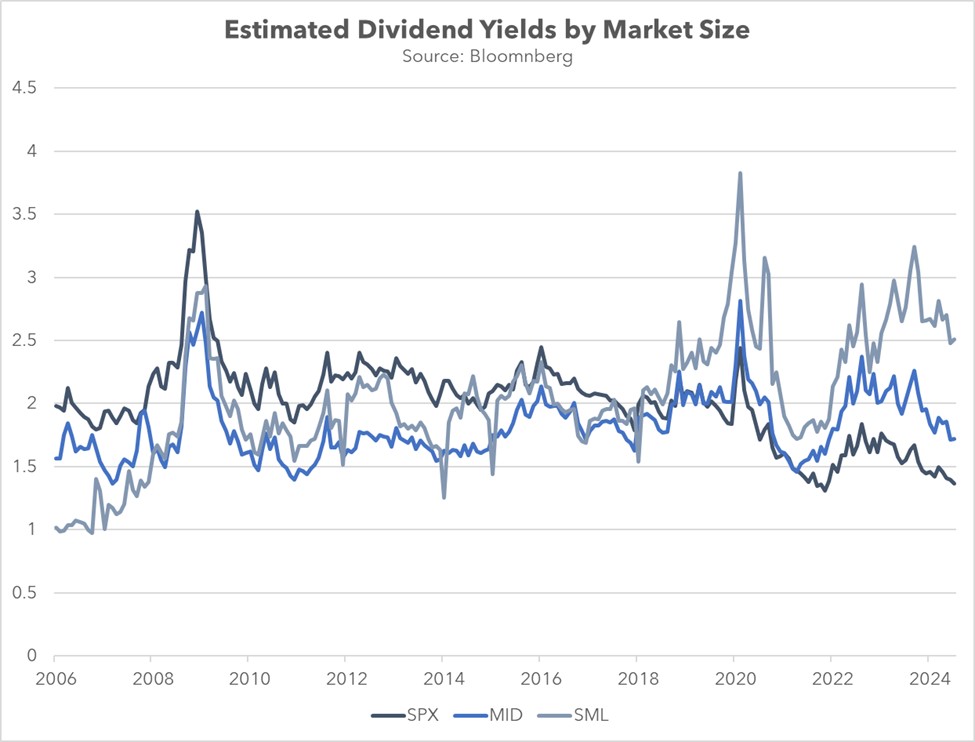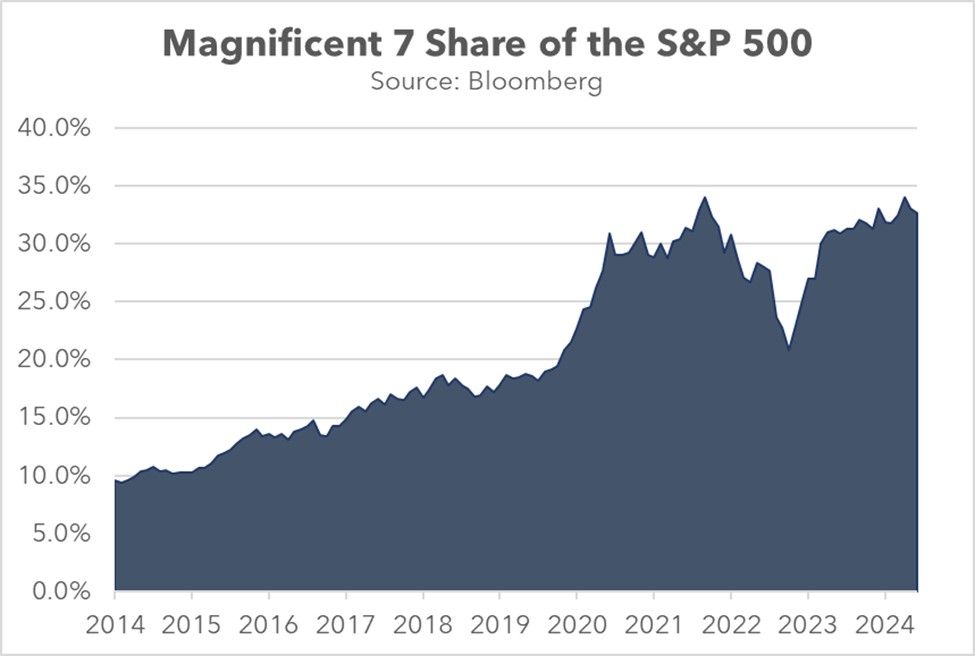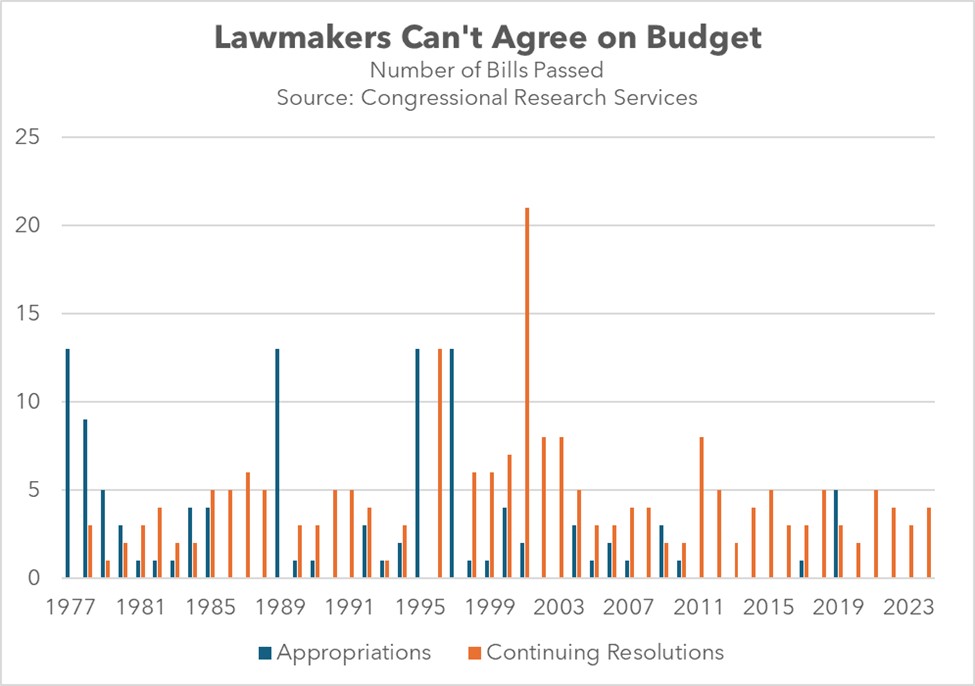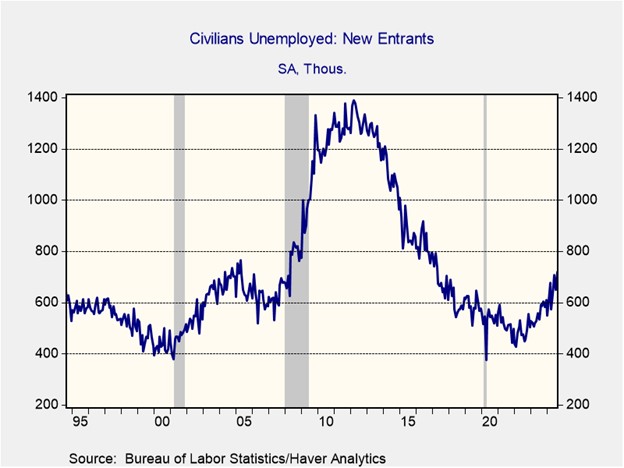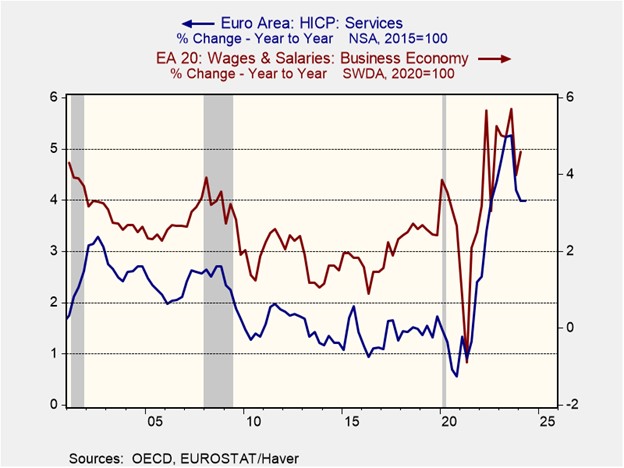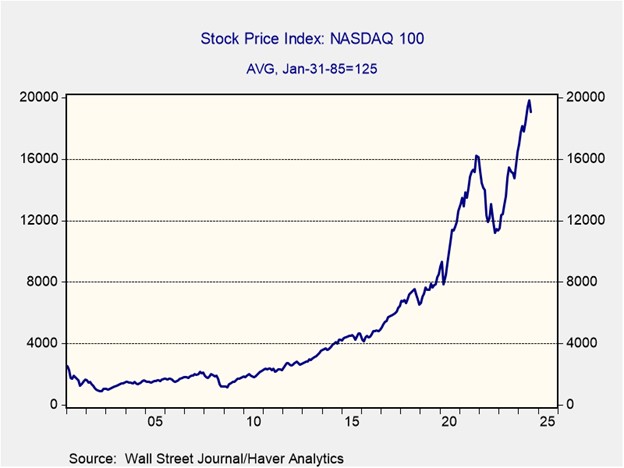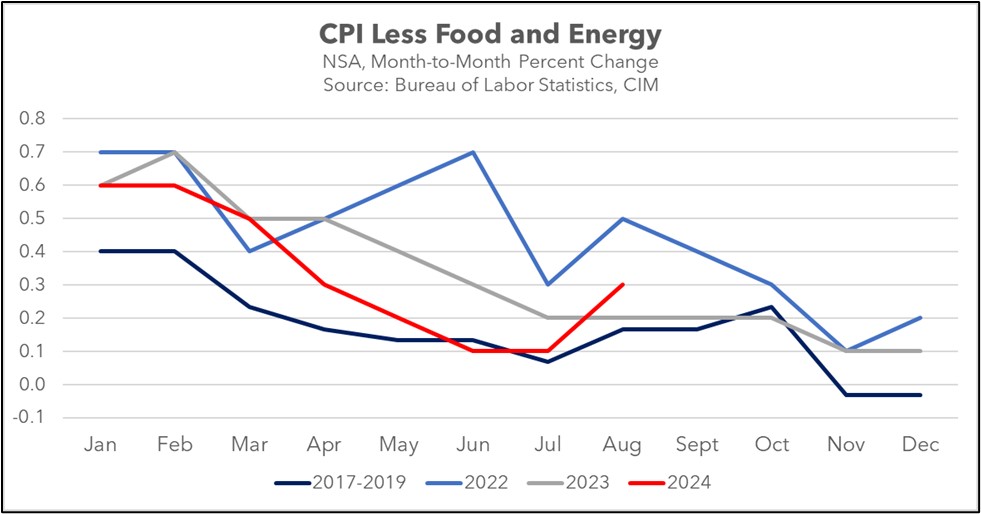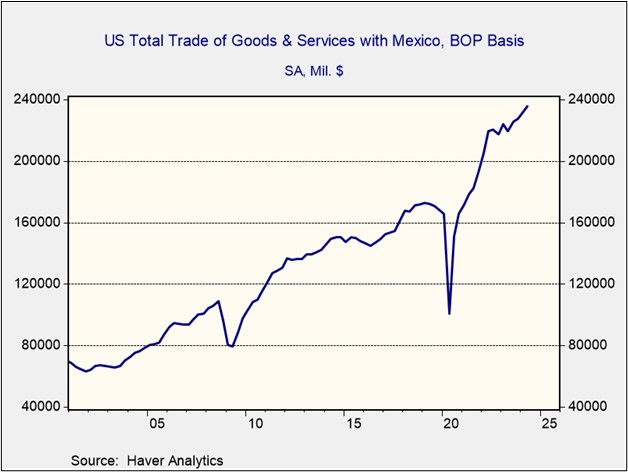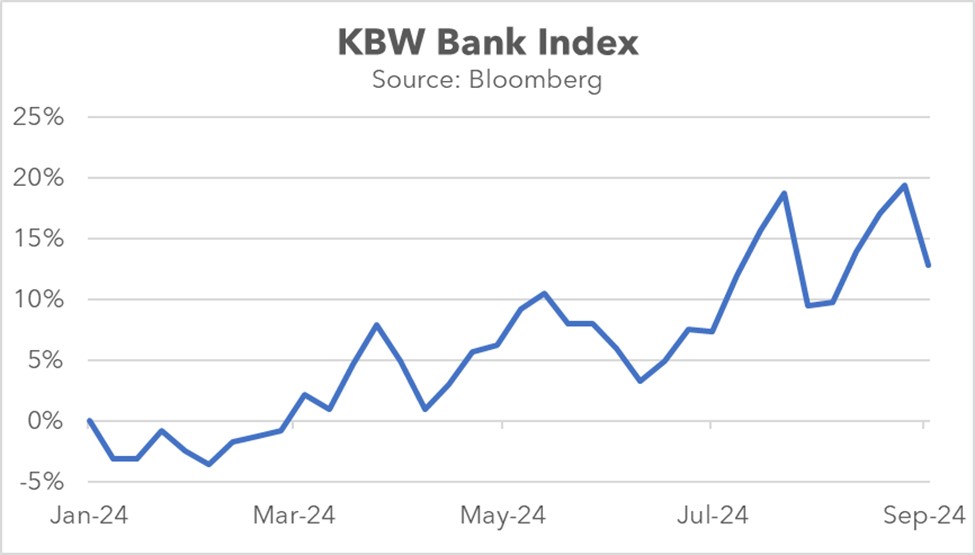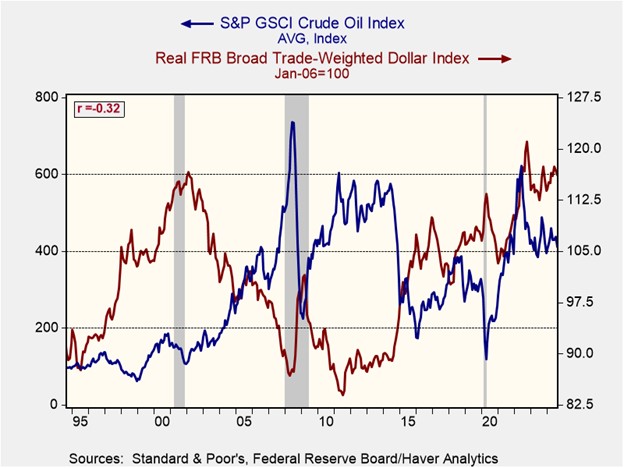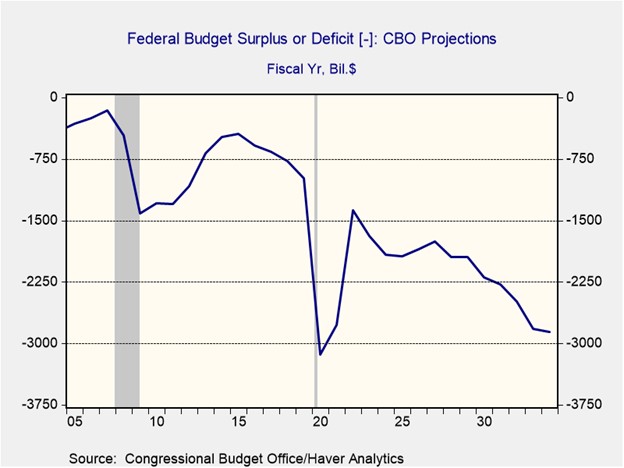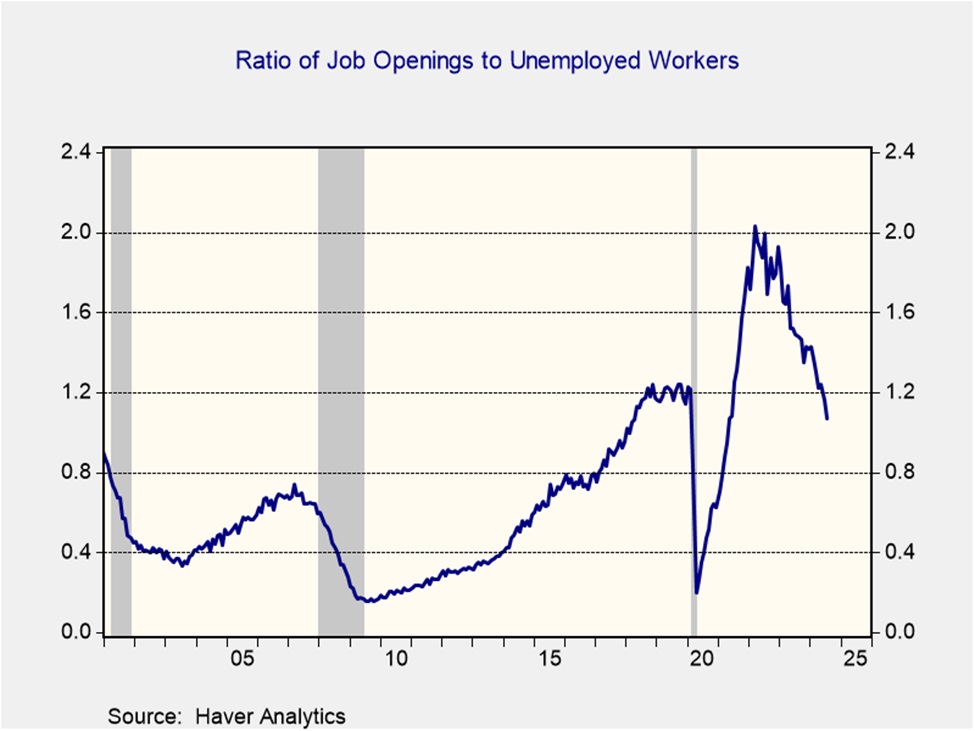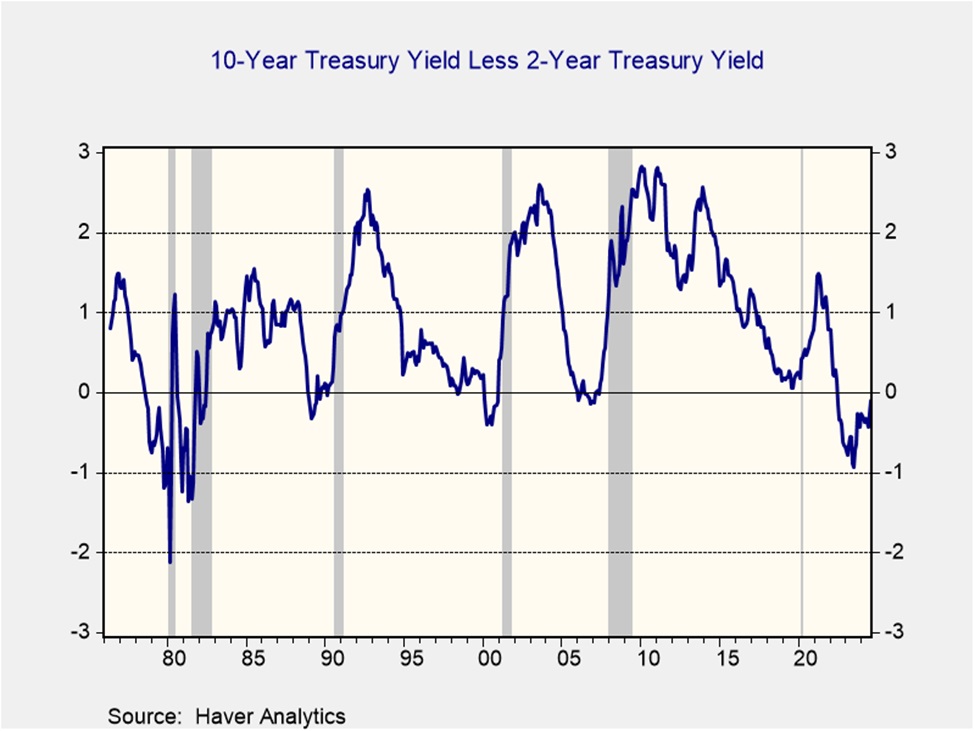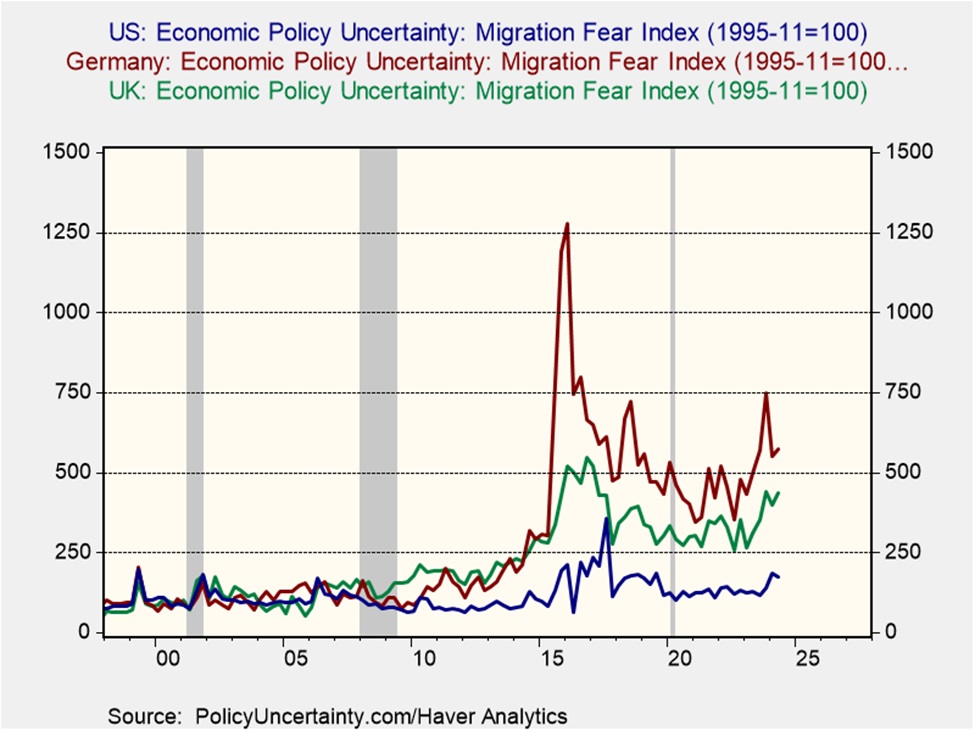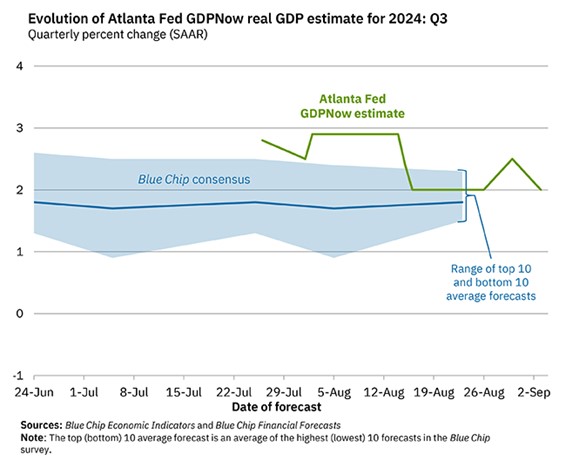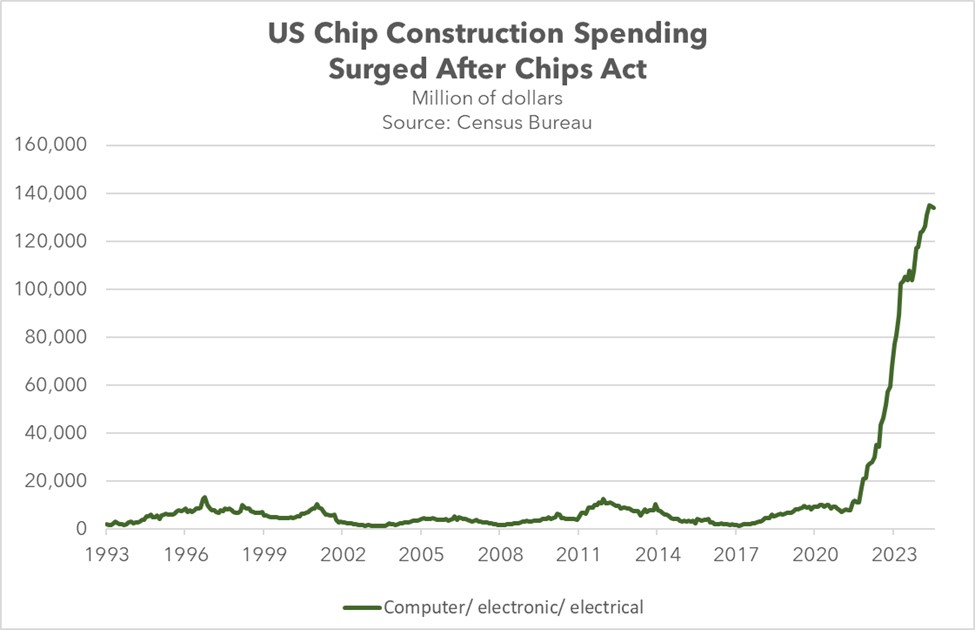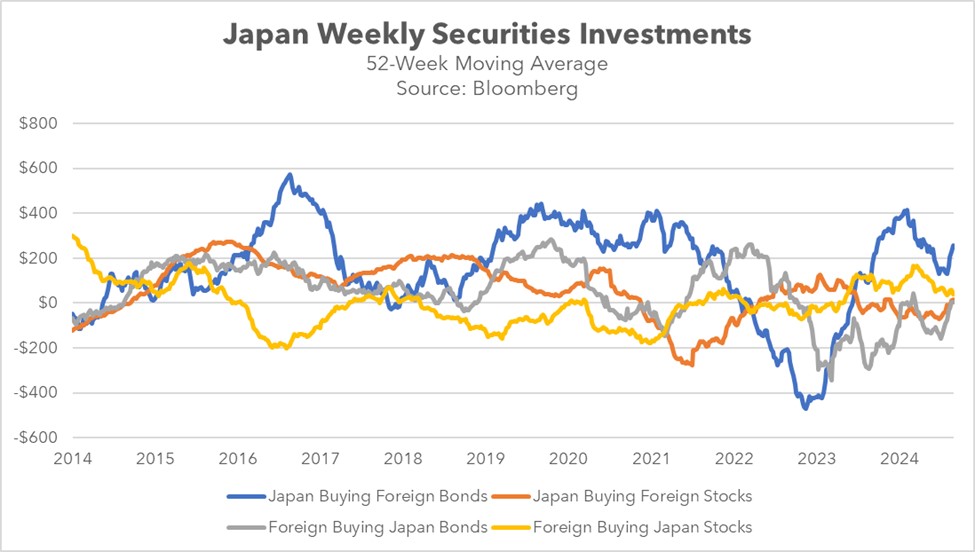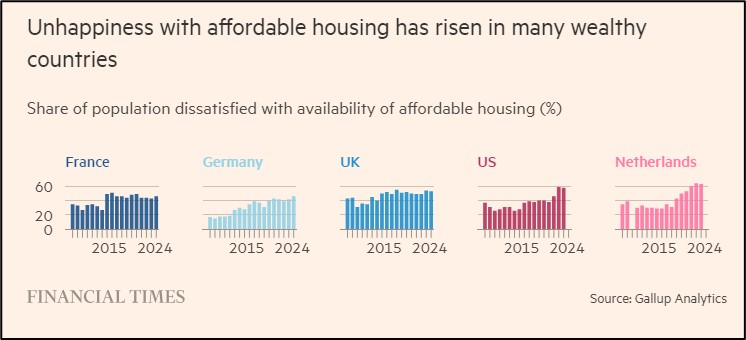Author: Amanda Ahne
Asset Allocation Bi-Weekly – The Benjamin Button Dividend (September 16, 2024)
by the Asset Allocation Committee | PDF
A company’s journey to industry prominence typically involves several stages: launch, growth, shakeout, maturity, and decline. Historically, large capitalization stocks were often considered to be in the maturity stage of their development. Many investors therefore assumed that these companies had strong enough earnings to initiate or maintain dividend payments, making them seem more attractive than their smaller counterparts that were primarily considered for their capital gains potential. However, recent trends suggest that times have changed.
Over the past seven years, small cap stocks have consistently surpassed their mid-cap and large cap counterparts in terms of estimated dividend yields. This gap can be attributed to both relative price appreciation and dividend policy. During this period, the large cap S&P 500 stock price index grew nearly twice as fast as the mid-cap S&P 400 price index and the small cap S&P 600 price index. Additionally, small firms have significantly increased their dividend payout ratios relative to their larger peers, from just under 40% to over 60% in the last decade. In contrast, large cap firms have maintained relatively stable dividend policies over the same period.
The primary shift in the relationship between the small cap and large cap indexes has been driven by a changing sectoral composition, largely due to the survivorship and maturation of technology companies. As smaller tech companies have grown and become more successful, they have been rebalanced into the large cap index or were bought out. Meanwhile, those that failed to move up were removed. This dynamic has led to a significant increase in the weight of the tech sector within the large cap index at the expense of the small cap index.
Over the past decade, information technology and communication companies have significantly increased their share of the large cap S&P 500 index, rising from 22.0% to 39.0%. In contrast, the small cap S&P 600’s exposure to tech companies has declined from 20.0% to 16.5%. As a result, the broad large cap index now exhibits more growth-like characteristics than its smaller counterparts. The S&P 500’s price-to-earnings ratio of 25.1 is substantially higher than those of the S&P 400 and S&P 600, which are each around 19.0. Moreover, the large cap index has become increasingly susceptible to price fluctuations in a select group of companies.
While tech companies have lost share within the small cap index, financial services and real estate firms have largely filled the void. Their rise was driven in part by low interest rates, which incentivized investors to seek assets with capital gains potential. This preference led to a surge in demand for large cap tech companies, which were perceived to have strong growth potential, at the expense of financial services and real estate firms, which paid dividends but were seen as less likely to appreciate significantly over time.
The substantial increase in the small cap index’s exposure to the Financials and Real Estate sectors is primarily attributable to reclassifications. Beginning in 2018, larger financial and real estate firms began to decline in market value, leading to their reclassification from the S&P 500 to the S&P 400. This trend intensified following the pandemic as many of these companies experienced further declines and they then made their way into the S&P 600.
These changes have resulted in a relative increase in the number of firms paying out substantial dividends within the small cap index. Over the past six years, the S&P 600’s exposure to financial and real estate companies has increased from 22.1% to 27.6%, while the S&P 500’s share has decreased from 17.6% to 15.7%. The S&P 400 saw a slight decline from 26.1% to 25.0% in its holdings of these sectors. Notably, the small cap index now has as many financial services and real estate firms as the large and mid-cap indexes had combined just 10 years ago.
Contrary to popular belief, a company’s size is not a reliable indicator of maturity. In fact, the average lifespan of S&P 500 companies has dramatically decreased in recent decades. The influx of tech companies into the large cap space has further accelerated this trend. In 1984, the average company survived 36 years, whereas today that figure is barely over 18 years. To put it into perspective, these companies are barely old enough to vote and not yet old enough to drink. This shorter tenure may explain why larger firms often exhibit less mature behavior than some of their smaller, dividend-paying counterparts, which have a weighted average lifespan of at least 32 years. In sum, investors seeking dividend income may now need to focus more on small cap companies than they did in the past.
Daily Comment (September 13, 2024)
by Patrick Fearon-Hernandez, CFA, and Thomas Wash
[Posted: 9:30 AM ET] | PDF
Good morning! Markets await more data to assess the economy’s health. In sports news, Dolphins quarterback Tua Tagovailoa suffered multiple concussions during the team’s loss to the Buffalo Bills. Today’s Comment delves into growing concerns about a government shutdown, explains why the Fed may not ease as aggressively as the market expects, and offers our perspective on the recent European Central Bank’s rate decision. As always, the report concludes with international and domestic data releases.
Shutdown Coming? With time running out, House officials are racing to prevent a government shutdown in October.
- House Minority Leader Hakeem Jeffries firmly stated that Democrats will not support the Republican funding bill. Earlier this week, Republican leader Mike Johnson had to withdraw a vote on the stopgap measure due to strong opposition from both House Democrats and members of his own party. A major sticking point is the proposed requirement for proof of citizenship to vote. Despite this, there is hope that a short-term funding agreement will keep the government open until mid-December.
- In the post-financial crisis era, political infighting has forced lawmakers to repeatedly extend government funding with temporary measures known as continuing resolutions. Only once since 2009 has more than one appropriation bill been passed before the October 1 deadline. These stopgaps prevent government shutdowns but also prolong the appropriation process and contribute to the ballooning budget deficit. The government has already relied on four continuing resolutions this year, which have helped push the deficit to $1.9 trillion. This puts it on track to be the largest deficit outside the pandemic era.
- While budget disputes are common, there seems to be a heightened risk of a government shutdown during the election this year. The ongoing political infighting over the budget is likely to raise investor concerns about the US government’s ability to address its fiscal challenges. The two major rating agencies have already downgraded the US credit rating, citing concerns about partisan gridlock preventing an agreement to reduce the deficit. As a result, we anticipate that continued political bickering over the debt will likely impact long-term interest rates in the future.
Too Much, Too Soon: The market remains optimistic about a significant shift in monetary policy, even though the economy is still demonstrating signs of resilience.
- As of today, market sentiment suggests a nearly 60% likelihood of the Fed implementing a rate cut of 125 basis points or more before year’s end. This expectation is fueled by concerns about a potential economic slowdown, which have been exacerbated by a series of weak labor market indicators. The rise in the unemployment rate in July, which triggered the Sahm Rule, along with this month’s confirmation of slowing hiring trends, has heightened concerns. However, we remain optimistic that the market may be getting ahead of itself.
- Historically, the Fed “takes the stairs up” during rate-hike cycles and “takes the elevator down” during rate cuts, typically in response to recessions. However, there are currently no clear signs of an economic downturn. The recent uptick in the unemployment rate is largely due to new entrants into the labor force. Meanwhile, the Atlanta Fed’s GDPNow forecast indicates a modest economic slowdown in the third quarter, with growth projected at an annualized rate of 2.5%, down from 3.0% in the previous month.
- The recent market reaction aligns with a pattern observed in the past two years, where investors often overestimate the likelihood of aggressive rate cuts in response to perceived economic weakness. This tendency has consistently been met with resistance from the Fed. Despite recent unfavorable data, the economy is expected to remain in expansion, suggesting that this pattern may continue in the coming months. While we anticipate a rate cut in September, we believe the Fed will adopt a more measured approach, with less reliance on jumbo cuts than the market currently expects.
ECB Rate Decision: The European Central Bank (ECB) has lowered benchmark interest rates for the second time in three months and has signaled more to come.
- The ECB on Thursday lowered its deposit rate by 25 basis points to 3.50%, signaling a shift in focus from inflation control to economic support. ECB President Christine Lagarde emphasized during a press conference that interest rates are not predetermined but are on a downward trajectory. While the central bank has not ruled out a rate cut in October, there is speculation that it might do so at the December meeting, when the central bankers will have more data to paint a better picture of the economy.
- Closely monitoring regional wage trends will provide valuable insights into the trajectory of services inflation. Unlike the US, which has experienced a steady rise in unemployment, the EU has witnessed a historic decline. This tight labor market has contributed to persistent wage pressures that have defied the central bank’s tightening efforts and the economic slowdown. This has translated to higher earnings, which explains nearly 60% of its variation of services inflation. As a result, if these wage pressures persist, the ECB may be forced to halt its easing cycle prematurely.
- Historically, the ECB has tended to be less aggressive than the US in raising rates during easing cycles but more cautious in lowering them. Given the persistent tightness of the labor market and its impact on wages, we anticipate that the ECB will likely adopt a more moderate approach to rate cuts to prevent a resurgence of inflation. This could help narrow the interest rate gap between the ECB and the US, potentially providing a boost to the euro. However, the currency could face downward pressure if inflation unexpectedly returns.
In Other News: OpenAI released a new artificial intelligence model that will help process complicated mathematical and coding problems. The development is a reminder of how AI capabilities are evolving. Former members of the Trump administration are considering selling shares in Fannie Mae and Freddie Mac in a move that could disrupt the housing market. Meanwhile, Russian President Vladimir Putin has threatened retaliation against a NATO ally if Ukraine is allowed to use US weapons to attack military bases in Russia, raising concerns about escalating tensions.
Daily Comment (September 12, 2024)
by Patrick Fearon-Hernandez, CFA, and Thomas Wash
[Posted: 9:30 AM ET] | PDF
Good morning! Markets are digesting the latest inflation data and closely watching for clues on the Federal Reserve’s upcoming rate decisions. In the sports world, WNBA star A’ja Wilson has etched her name in the history books by breaking the single-season scoring record and solidifying her bid for another MVP award. In today’s Comment, we will delve into the continued investor optimism surrounding AI technology, analyze the mixed implications of the CPI report on inflation, and explore the potential impact of Mexican judicial reforms on trade. As always, we’ll conclude with a review of the latest domestic and international economic indicators.
AI Hype is Back? OpenAI’s latest funding round has boosted investor confidence that AI is here to stay.
- The Microsoft-backed AI startup is in negotiations to secure $6.5 billion in new funding from investors. This significant investment could nearly double the company’s valuation from $86 billion to $150 billion. Such a valuation would further solidify the company’s position as one of the most promising startups globally. The AI company claims that the fresh capital will be used to expand its computing power and cover operational costs. However, there is speculation that this financing round could signal the company’s ambition to go public.
- OpenAI’s recent initiative underscores the surging demand for generative AI technology, a trend echoed by the escalating investments of the “Magnificent 7.” Notably, Amazon, Microsoft, Google, and Meta have all recently announced plans to significantly bolster their AI spending. While these moves have been met with a degree of skepticism from investors who would prefer a more diversified approach, they highlight the intensifying competition among these tech giants as they vie for dominance in the burgeoning AI market.
- As Big Tech companies continue to scale their AI operations, they will require access to advanced, energy-efficient chips. This surging demand has already pushed chip manufacturers like Nvidia to their limits, with the company struggling to keep up with the overwhelming demand for its latest-generation Blackwell chip. Utility companies have also faced mounting pressure to supply the substantial energy needs of these firms that are expanding their data centers. While some investors may have cooled on the Magnificent 7, it’s clear that these companies still command significant investor interest.
Shelter Still a Problem: While consumer inflation dipped in August, persistent underlying price pressures suggest that the fight against inflation is far from over.
- The overall consumer price index (CPI) increased a modest 0.2% last month, while core CPI, excluding food and energy, rose 0.3%. While this data suggests a general alignment with the central bank’s inflation mandate, significant hurdles remain in achieving its ultimate goal. Commodities continue to provide a bright spot, with food at home and energy prices contracting last month. However, price pressures in services remain a major concern, particularly shelter costs, which accelerated at more than twice the pace of the overall index.
- The disproportionate impact of shelter inflation on the broader price index reflects a lingering effect of the pandemic. The government’s cautious stance on ending eviction moratoriums, coupled with uneven state-level policies, has slowed the pass-through effects of home and rent prices on the CPI. As a result, overall and core CPI have risen by 2.5% and 3.2%, respectively, compared to the previous year. In contrast, overall and core CPI excluding shelter costs reveals much smaller increases of 1.1% and 1.6%, highlighting the significant role of shelter inflation in driving up these measures.
- As a result, the Federal Reserve may be more inclined to downplay the recent sharp increase in core inflation to avoid the further cooling of the labor market. This could indicate a greater willingness to lower interest rates than previously expected, potentially revisiting the March projection of a 50-75 basis point reduction by year-end. However, due to the recent rise in month-over-month inflation figures, the Fed is likely to adopt a more cautious approach. Consequently, we anticipate that the initial interest rate cut will be a modest 25 basis points.
Mexico Judicial Reforms: Mexican President Andrés Manuel López Obrador (AMLO) has made significant progress toward consolidating his ruling party’s control over the judiciary before the end of his term.
- On Wednesday, the Mexican Senate passed a significant judicial reform that would require judges at all levels, including the Supreme Court, to be elected by the public rather than appointed. This follows the lower house’s approval of the legislation last week. The reform now awaits ratification by state legislatures, which are largely controlled by AMLO’s Morena party. Once the legislation becomes law, it is likely to lead to a confrontation between Mexico and its USMCA trade partners as they seek to ensure fair arbitration mechanisms.
- Since taking office, AMLO has pursued a strategy of government control over the country’s energy market, creating conditions that favor state-owned companies in securing contracts over foreign competitors. This approach has strained Mexico’s relationship with its two major trading partners, particularly the United States, as it is in violation of the USMCA agreement. Last year, a federal court struck down an electricity law backed by AMLO, citing anti-competitive practices. Earlier this year, the Supreme Court also ruled against his initiative to grant favorable contracts to state companies.
- Incoming President Claudia Sheinbaum, who is set to assume office on October 1, has sent mixed signals to investors by affirming her commitment to judicial reforms while simultaneously pledging to protect private investors. This ambiguity has heightened investor concerns about her stance on nationalization, leading to a pause in further investments. If she continues to follow in the footsteps of her predecessor, Mexico’s reputation as a reshoring hub could be tarnished. Additionally, it may lead to a trade war and jeopardize the future of USMCA, which is scheduled for a review in July 2026.
In Other News: Canada’s defense minister has thrown cold water on the idea of an Asian NATO, as the West looks to prevent an unnecessary escalation of tensions with China. The European Central Bank cut rates by 25 bps as it looks to prevent the economy from slowing down further. Spanish Prime Minister Pedro Sánchez has urged the EU to seek a compromise on Chinese EV imports rather than to follow through on planned tariffs. His reluctance is a reminder of how divided the EU is when it comes to China.
Confluence of Ideas – #37 “Reviewing the Asset Allocation Rebalance: Q3 2024” (Posted 9/11/24)
Daily Comment (September 11, 2024)
by Patrick Fearon-Hernandez, CFA, and Thomas Wash
[Posted: 9:30 AM ET] | PDF
Good morning! The market is currently digesting the latest inflation data. In sports news, NBA Commissioner Adam Silver has hinted at the possibility of another expansion team. Today’s Comment will explore why banks remain pessimistic about the future despite a recent regulatory win, how lower oil prices could weigh on the US dollar, and the key takeaways from the second presidential debate. As always, our report will conclude with a roundup of domestic and international news releases.
Banks Are Less Optimistic: While banks received some good news on Wednesday, the outlook for the sector remains bleak.
- In response to pressure from the financial services industry, the Federal Reserve announced a reduction in the proposed capital requirement increase on Tuesday, from 19% to 9%. While the initial proposals targeted banks with assets exceeding $100 million, the revised version primarily applies to those with assets over $250 million. The decision aims to alleviate concerns from banks about the potential impact the requirement would have on their lending capacity. However, there are concerns that relaxed rules could leave the door open for another financial crisis.
- That said, concerns persist about the outlook for financial firms. JP Morgan Chase has cautioned that anticipated earnings may be overly optimistic and cited the Federal Reserve’s expected interest rate cuts as a significant threat to net interest income, a key driver of its recent success. Meanwhile, auto lender Ally Financial has reported higher-than-expected car loan delinquency rates, raising concerns about its ability to deliver strong returns. This weaker outlook coincides with growing fears of consumer backlash as households grapple with rising prices and a deteriorating labor market.
- Despite expectations that the Federal Reserve will ease monetary policy in the near future, the impact on banks remains uncertain. While lower interest rates generally encourage lending in a strong economy, banks may now be reluctant to extend credit due to concerns about future default risk. Moreover, the recent Senior Loan Officer Opinion Survey (SLOOS) suggests that financial institutions are already tightening their lending standards. If this trend persists, we anticipate a moderation in economic growth but not a recession.
Oil Gets Cheap: Concerns about insufficient demand have pushed oil prices to their lowest level in nearly three years.
- Brent crude futures fell below $70 on Tuesday, driven by mounting global economic concerns. Weak economic data from China and a second downward revision within two months by OPEC to its demand forecast contributed to the drop. The oil-producing group now projects daily demand growth of around two million barrels, reducing its previous estimate by 80,000 barrels. This adjustment comes in the wake of reports indicating that Chinese imports increased by just 0.5% from the previous year, falling short of the anticipated 2% growth predicted by analysts.
- Declining oil prices could negatively impact the US dollar. In recent years, the United States has become a major exporter of natural gas and crude oil, a trend that accelerated after the war in Ukraine led to increased demand for alternatives to Russian oil. This shift has altered the US terms of trade, which measure the relative change in import to export prices, as the country transitioned from a net oil importer to a net exporter. As a result, the US dollar and oil prices have flipped from a negative to a positive correlation.
- Nevertheless, the 2024 oil market has been characterized by a significant supply-demand imbalance. Lackluster GDP growth in China and Europe, coupled with slowing economic momentum in the United States, has reduced global oil demand. While OPEC has reduced production to bolster price levels, increased output from Brazil, Canada, Guyana, and the United States has offset much of the supply cuts. Consequently, the combination of robust production and weakening demand has led to a surplus of fuel inventories that has kept a lid on prices, which should weigh on the dollar.
Fireworks But No Substance: Republican and Democratic presidential candidates Donald Trump and Kamala Harris debated on Tuesday but offered few insights into their planned direction for the country.
- During the debate, neither candidate was willing to delve into the specifics of their plans for the country. Harris emphasized her intention to offer tax cuts for small businesses and provide a credit to first-time homebuyers to help them purchase their first home. Meanwhile, Trump reminded Americans of his plan to significantly strengthen border security to address the immigration surge. Beyond these points, the leaders engaged in a heated exchange of insults regarding their respective records in office, which was somewhat entertaining but ultimately unproductive.
- Despite both candidates’ enthusiasm for outlining their spending plans, neither has provided a clear explanation of how they intend to finance these initiatives. Trump has proposed extending previous tax cuts, exempting Social Security and tips from taxation, and lowering corporate tax rates. In contrast, Harris has pushed for a $25,000 tax credit for first-time homebuyers, an extension of childcare tax credits, a $6,000 bonus for newborns, and the elimination of taxes on tips. While both candidates claim to have deficit-reduction plans, neither was willing to discuss these strategies during the debate.
- While Trump previously secured a decisive victory over President Joe Biden in the first debate, early assessments suggest that Harris may have gained the upper hand in the second contest. The next debate is set to take place in three weeks between Ohio Senator JD Vance and Minnesota Governor Tim Walz. Meanwhile, the Harris and Trump campaigns are discussing the possibility of another debate. Current betting odds indicate that the race remains relatively close, with Harris receiving a small bump following last night’s performance.
In Other News: The US, for the first time, accused China of directly supporting Russia’s invasion of Ukraine. This decision reflects Washington’s increasing efforts to rally European support for its isolation of China. Meanwhile, lithium share prices have surged following the closure of two Chinese mines by CATL. This event serves as a stark reminder of the volatile nature of commodity prices in a world that is becoming increasingly disconnected. Automaker Volkswagen has decided to end its job security agreement as it looks to chart a more profitable path forward.
Daily Comment (September 5, 2024)
by Patrick Fearon-Hernandez, CFA, and Thomas Wash
[Posted: 9:30 AM ET] | PDF
Good morning! The market is eagerly awaiting the services PMI data, seeking signs that the economy remains resilient. In sports, Cristiano Ronaldo and Lionel Messi have both been left off the Ballon d’Or shortlist for the first time since 2003. Today’s Comment will cover the latest jobs data and its implications for the Fed, why we remain optimistic that the economy is not in recession, and what Michael Barnier’s rise in France reveals about immigration trends in the West. As always, we conclude with a roundup of international and domestic news.
Labor Cooling: The latest employment data reinforced the view that firms are starting to slow down hiring.
- The July Job Openings and Labor Turnover Survey (JOLTS) from the Bureau of Labor Statistics reported a sharp decline in job openings, reaching their lowest level since January 2021. Listings dropped from a revised 7.910 million to 7.673 million, suggesting a potential cooling of the labor market. In response to the report, Atlanta Fed President Raphael Bostic stated that the risks of inflation and unemployment are now balanced, likely signaling his full support for a rate cut at the FOMC’s September meeting.
- The weakening JOLTS data has intensified concerns that the central bank may have kept rates too high for too long. The ratio of job openings to unemployed workers has now dipped below pre-pandemic levels, with approximately one job opening for every unemployed individual. Although the ratio itself remains historically high, its significant decline from the peak of nearly two job postings for every available worker further cements the shift in attitudes about the labor market following last month’s triggering of the Sahm Rule.
- While the JOLTS data is disappointing, it is likely to be overshadowed by Friday’s jobs report, which is expected to show a sizeable increase in payrolls from 114,000 to 160,000 and a slight decline in the unemployment rate from 4.3% to 4.2%. A stronger-than-expected jobs report could undermine expectations for an aggressive easing cycle as it may signal that July’s job losses were a one-time occurrence due to Hurricane Beryl. Assuming the economy maintains its resilience, we anticipate the Fed will cut rates one to two times this year.
Disinversion: Growing concerns about the economy caused short-term rates to briefly rise above long-term rates as the market anticipates a strong response from the Fed.
- The Federal Reserve’s Beige Book revealed that the country is starting to feel the weight of tight monetary policy, with the number of districts reporting flat or declining activity increasing from five to nine. In response to the slowdown in business activity, firms indicated a preference for reducing hours, cutting shifts, and slowing hiring rather than implementing layoffs. Despite these measures, firms expressed optimism about a potential economic recovery in the near future. Additionally, the report revealed a moderate increase in both prices and wages.
- Weak jobs data and a gloomy Fed outlook caused the market to reassess its policy rate expectations. On Wednesday, the yield curve briefly disinverted, with the two-year Treasury rate ending the day a tad lower than the 10-year. The recent upward slope of the yield curve indicates that investors believe the Federal Reserve will need to significantly lower interest rates to stimulate the economy. The latest CME FedWatch tool reflects this sentiment, indicating a 44% chance of a 50-basis-point rate cut in September, up from 34% last week but still below the peak of 85% seen a month ago.
- While traditional wisdom suggests that yield curve inversions are a reliable precursor to economic downturns, data suggests that the disinversion of the curve might be a better indicator, as the chart above shows. Historically, the normalization of the yield curve has been followed by economic downturns. However, it’s important to note that previous disinversions were often driven by the Federal Reserve’s response to something breaking in the financial system. At this time, we see little evidence of market distress and we remain confident that the economy will demonstrate its resiliency over the next few months.
Immigration Fears Rise: A new French prime minister has been selected, and he’s likely to steer the French parliament further to the right.
- Michael Barnier, conservative leader and former EU Brexit negotiator, has been appointed as France’s next prime minister. Speculation about his potential nomination surged after conservative Xavier Bertrand and former socialist Prime Minister Bernard Cazeneuve fell out of favor. Barnier, who kept a low profile after failing to secure his party’s 2022 presidential nomination, had taken a hardline stance on immigration during that campaign, proposing a three-to-five-year moratorium on non-EU arrivals.
- Barnier’s selection likely reflects the growing prominence of immigration as a political issue across the West. While conservative parties lacked parliamentary seats to show it, they won the popular vote in France’s July legislative elections, with a significant share going to Marine Le Pen’s anti-immigration National Rally. This trend has been evident elsewhere, such as in Germany, where a far-right party recently won a state election for the first time since WWII, and in the UK’s decision to leave the EU. Even in the US, both presidential candidates have adopted increasingly restrictive stances on immigration.
- Tougher immigration policies could hinder efforts to combat inflation. The influx of foreign workers has played a crucial role in mitigating wage pressures, which have contributed to elevated inflation. A slowdown in the growth of foreign workers could require firms to rely more heavily on productivity improvements to maintain costs. While this is achievable, the timing and nature of such technological shifts are uncertain. However, it’s highly probable that service inflation would remain elevated due to this policy change.
In Other News: President Joe Biden is expected to block Nippon Steel’s takeover of US Steel, underscoring the commitment to protecting domestic industries in the US. Meanwhile, Elon Musk’s Starlink has agreed to restrict access to X in Brazil, reflecting a growing trend of governments tightening control over tech companies. The Bank of Canada lowered its policy rate by 25 bps for a third consecutive meeting in a sign that global financial conditions are loosening.
Daily Comment (September 4, 2024)
by Patrick Fearon-Hernandez, CFA, and Thomas Wash
[Posted: 9:30 AM ET] | PDF
Good morning! Markets remain cautious amid lingering concerns about a potential recession. In sports news, Taylor Fritz advanced to his first Grand Slam semifinal at the US Open by defeating Alexander Zverev. Today’s Comment will delve into why recent manufacturing data has not dampened our economic outlook, explain why setbacks have not hindered the development of semiconductor factories, and provide insights on the impact that the Bank of Japan’s monetary tightening is having on financial markets. As always, our report will conclude with a summary of key international and domestic data releases.
Market Jitters: Weaker-than-expected purchasing manager reports weighed on equities on Tuesday as investors grew concerned about the economic outlook.
- The August purchasing managers’ indexes (PMI) from ISM and S&P Global both confirmed a sustained contraction in the manufacturing sector for the second month in a row. Although the ISM index, which is weighted toward larger companies, showed a slight increase, both indexes remained below the expansion threshold of 50. These weak reports were further supported by evidence of declining demand. The ISM index indicated a deeper contraction in new orders and a pickup in inventory levels. Meanwhile, S&P Global reported a seventh consecutive month of declining sales.
- Despite ongoing challenges in the manufacturing sector, the overall economy remains resilient. The service industry, which constitutes nearly half of economic output, continues to drive growth. Meanwhile, goods consumption accounts for approximately a fifth of the economy. Moreover, the labor market remains relatively insulated from the industrial downturn, with over 80% of private sector jobs being service oriented. As a result, the latest Atlanta GDPNow forecast indicates a projected annualized growth rate of 2.0% for the third quarter of 2024, down slightly from the previous forecast of 2.5%.
- Market volatility is expected in the coming weeks as investors await the Federal Reserve’s next policy decision. Although the Fed has hinted at a possible rate cut this month, uncertainty persists regarding the extent of cuts this year. The Fed’s recent economic projections suggest a more cautious approach with just one cut, which contrasts with the market expectations of three to four cuts. In our view, the Fed’s strategy will largely depend on Friday’s jobs report. A strong report could prompt a moderate rate reduction, while a weaker report might lead to strong policy measures to prevent a hard landing.
The Construction Goes On: Semiconductor factory construction spending continues to skyrocket even as firms face roadblocks.
- Concerns are mounting that not all CHIPS Act projects will be fully realized. Intel, in particular, faces significant challenges. The company reported a $1.61 billion net loss last quarter and is exploring the sale or spin-off of its manufacturing division. This setback has raised concerns about the company’s ability to meet production targets necessary for securing CHIPS Act funding. Additionally, companies across the semiconductor industry have encountered opposition from local community groups due to environmental concerns, potentially delaying permit approvals.
- Despite significant funding challenges, the trajectory of domestic semiconductor facility construction remains robust. The development of semiconductor manufacturing hubs has reached its highest level in nearly half a century, with investments in facilities specifically for computer, electronics, and electrical manufacturing accounting for nearly 60% of the total spending as of July. This represents a substantial increase compared to a decade ago, when such investments accounted for approximately 8%. The sharp uptick suggests that firms may be willing to take a chance in hopes that it will pay off in the future.
- The development of domestic semiconductor fabrication plants (fabs) is likely to continue for national security reasons, but their long-term viability may be a concern if firms cannot significantly reduce costs. It has been widely speculated that firms may rely heavily on automation in these new facilities to maintain profitability. However, this could lead to push back from lawmakers who want the firms that have received funding to increase hiring for manufacturing workers. While we do not currently see this as a significant issue, it could become a potential problem in the future.
BOJ Hawkish Turn: Despite growing recessionary concerns in Japan, the central bank remains committed to its ongoing interest rate hike cycle.
- Bank of Japan (BOJ) Governor Kazuo Ueda reaffirmed that the central bank will raise rates if the economy and inflation evolve as expected. His comments come after the market sell-off in early August, partly triggered by the bank’s unexpected decision to raise interest rates. Following this move to tighten monetary policy, the central bank cited the weakness of the country’s currency as one of the reasons for the increase, adding that it believes the decision could support, rather than hinder, economic growth. Following the comments from Ueda, the JPY strengthened against the USD.
- Despite recent market volatility, Japanese investors continue to show a strong appetite for foreign assets. Over the last few years, the BOJ’s historically low rates have encouraged them to seek higher yields abroad, fueling demand for foreign bonds and equities. This foreign investment has helped lower borrowing costs for governments worldwide, especially the United States, and has supported global equity markets. As interest rates rise and the yen strengthens, some foreign capital may be repatriated to Japan, but the overall trend currently remains supportive of overseas investment.
- Although concerns about a more aggressive Bank of Japan have unnerved global investors, it’s crucial to note that Japanese bond yields remain exceptionally low relative to their G-10 peers. Despite hawkish rhetoric, the central bank is still likely to implement a gradual tightening cycle as the world adapts to post-pandemic conditions. While the possibility of another carry-trade driven market panic cannot be entirely dismissed, the market seems to be accepting that ultra-easy monetary policy is nearing its end. This shift should temper the market’s reaction for the BOJ’s next hike which is expected in January.
In Other News: The Department of Justice has subpoenaed Nvidia over allegations of antitrust violations, signaling a tougher government stance on tech firms. Meanwhile, a former aide to New York Governor Kathy Hochul has been arrested on charges of working on behalf of the Chinese government. Additionally, the People’s Bank of China is considering a policy adjustment that could result in an 80 basis point rate cut for mortgages, indicating a willingness to adopt more aggressive measures to stimulate growth.
Daily Comment (September 3, 2024)
by Patrick Fearon-Hernandez, CFA, and Thomas Wash
[Posted: 9:30 AM ET] | PDF
Our Comment today opens with a global poll showing that dissatisfaction with high home prices and rental rates is now widespread across the developed world, although it’s unclear whether that will spur lower interest rates or increased homebuilding to improve affordability. We next review several other international and US developments with the potential to affect the financial markets today, including more dangerous interactions between Chinese and Philippine ships in the South China Sea and a statement by Vice President Harris that she opposes the takeover of US Steel by a Japanese steel manufacturer.
Global Housing Market: While it’s tempting to think only people in the US are mad about high home prices and rising rents, new research from Gallup shows voters are dissatisfied across the developed world. Indeed, the population-weighted average rate of dissatisfaction in the countries of the Organization for Economic Cooperation and Development now stands at about 50%. OECD economists tag the shortfall to both high interest rates and insufficient homebuilding, especially at lower price points, which has boosted home prices and rents.
European Union: The European Court of Justice today ruled that the EU’s competition regulator exceeded its authority when it blocked US gene-sequencing firm Illumina’s takeover of cancer-test maker Grail. According to the court, the regulator had no jurisdiction to review the case, and the legal tool it used to block the merger was used improperly.
- The ruling is a blow to the EU’s strategy of blocking so-called “killer acquisitions,” where a firm buys a much smaller player to eliminate a source of potential competition, even if the target currently has little or no EU revenue.
- The aggressive EU strategy has been one bone of contention between EU regulators and powerful technology-oriented companies in the US.
Germany: In state elections on Sunday, the anti-immigrant, far-right populist Alternative for Germany (AfD) came in first in the eastern German state of Thuringia and second in Saxony. The results mark the best showing for a far-right party in Germany since the Nazi period in World War II. It appears that a new populist-left party, the Sahra Wagenknecht Alliance (BSW), will finish third in both states, potentially making it a kingmaker.
- AfD’s strong performance points to continued gains by the far right in the European Union, raising concerns about political stability in the bloc and its prospects for staying intact.
- More generally, the rise of some far-left parties in Europe point to worsening polarization, which will make it even harder for EU leaders to keep the bloc together, formulate policy, and support the economy and financial markets.
Switzerland: In a shocking report late last week, a panel of diplomats, high-level government officials, and military officers told the government that it should consider abandoning the country’s vaunted neutrality policy, which has been in place since 1515. Faced with Russia’s growing aggression, the report says Switzerland should consider developing the capability to work with the European Union and the US in defense matters. It also recommends that Switzerland end or revise its ban on selling weapons to countries at war.
China-Philippines: Over the weekend, a Chinese coast guard vessel once again harassed a Philippine coast guard ship in disputed waters in the South China Sea. To be precise, multiple Chinese vessels surrounded BRP Teresa Magbanua near Sabina Shoal, and one repeatedly rammed her. We have also seen reports that the Philippine ship has now turned off her location transponder, either deliberately because she is trying to hide from the Chinese, or perhaps because she has been boarded and taken over by the Chinese.
- China’s continual harassment of Philippine ships, including multiple instances of ramming and other physical contact, suggest the territorial disputes in the South China Sea will continue to present a risk of broader conflict.
- As we have noted previously, the US and the Philippines have a mutual defense treaty, and Manila has implied that if a Philippine sailor is killed in a conflict with China, it might turn to the US to help defend it.
China-Canada: Beijing today said it will investigate whether Canada is dumping canola on the Chinese market at predatory prices. The anti-dumping probe is almost certainly in retaliation for Ottawa’s decision last week to impose anti-dumping tariffs on Chinese steel, aluminum, and electric vehicles. The new probe by China is the latest sign of a possible global trade war as Beijing tries to boost economic growth by flooding the world with its exports and major developed and emerging countries erect trade barriers to protect their workers.
United States-South Korea-China: As the Biden administration continues trying to cajole US allies into clamping down further on selling advanced semiconductor technology to China, the South Korean trade minister yesterday said Washington should provide incentives for Seoul to play along. The statement reflects some allies’ resistance to losing lucrative trade flows with China, even as many business leaders in the US and the rest of the US-led geopolitical bloc resist giving up on the Chinese market.
US Economic Policy: Illustrating how nationalist populism has been embraced by both major political parties, Democratic Vice President Harris yesterday said she would oppose Japanese steelmaker Nippon Steel’s pending takeover of US Steel. Harris’s opposition to the deal, made at a union hall in Pittsburgh as part of her presidential campaign, echoes the opposition from President Biden, former President Trump, and other Republican and Democratic lawmakers.
- As we’ve noted before, populist policies are likely to be reflected in the major policies put into place whether Trump or Harris wins the presidential election in November.
- Those policies are likely to include more trade barriers and protectionism, more industrial policy to favor certain domestic industries, and tax cuts and benefit programs for the working class. Of course, the specific policies pushed by Trump or Harris would be different, but many will probably be geared to addressing today’s populist sentiment.



